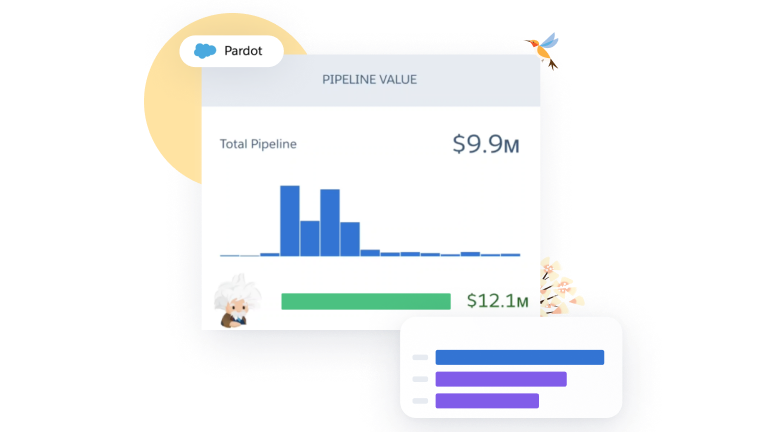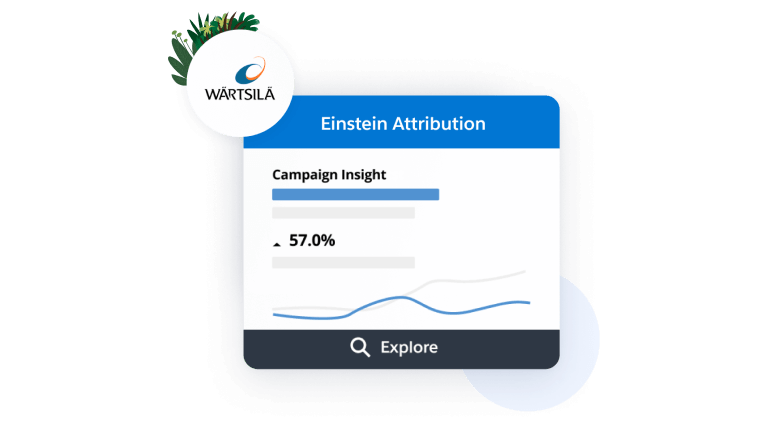Chapter 2: How Can You Achieve Return on Marketing Investment Fast?

Now that we know the basics behind MROI and how to calculate it, how can B2B marketers reach their desired MROI in a timely manner? The answer lies in quality lead generation. Digital technology has put scores of potential leads easily within the grasp of most businesses. But when it comes to marketing success, lead generation is about quality over quantity. A smaller database stocked with qualified leads is worth far more than an enormous stockpile of dead-end prospects.
Leverage Data to Target the Right Accounts
That’s one reason why so many businesses are turning to account-based marketing (ABM) to grow their business — and reach their MROI — faster. It’s a strategy that joins data management with marketing automation to create personal campaigns for the B2B customers you most want to reach.
In ABM, sales, marketing, and service teams join forces to identify the key accounts that matter most to their business — the ones with the highest revenue potential and strongest buying signals. These groups work together to share data and insights before and after the deal is closed so that anyone on the team can deliver personalized, connected engagements to every buyer on the account.
Usually, the number of accounts you’re marketing to in ABM is relatively small. However, this is by design. Its account-centric approach saves you time and resources by acquiring high-value customers faster and growing existing customer relationships more strategically through upsell and cross-sell opportunities and elevated service.
Prioritize and Nurture Quality Leads
ABM is an effective strategy that helps B2B marketers support more complex organizations, but it can’t be done well without the right technology. Rapid adoption of a quality marketing automation tool is a proven way to boost your MROI fast. Marketing automation works to improve the quality of your leads in two key ways:
- Lead scoring and grading separates quality top-of-funnel leads from the pack, so you can focus resources where they matter most.
- Lead nurturing campaigns tighten your funnel, ensuring that quality leads don’t slip through the cracks.
Passing quality leads to your sales team not only improves their chances of closing a deal, it saves them from wasting time chasing unqualified prospects who aren’t ready to buy.
Of course, you have to find leads before you can qualify them and pass them to your sales team. That’s where it helps to have some good lead generation tactics at the ready. According to the Salesforce State of Marketing report, the three channels with the highest lead generation ROI are:
- Influencers
- Social publishing/advertising
- Websites
Learn more about how to use these channels and how they can support your lead gen efforts within each stage of the marketing funnel in our How to Grow Your Business with Lead Generation guide.
Grow Trust Through Relationship Building
But today’s customers aren’t just looking for great products and services at fair prices. They want to trust your brand and feel good about what they’re buying. Earning a new customer’s trust means building a relationship with them over time. Ultimately, lead generation is about using the right channels to find high-quality leads you can turn into relationships.

From there, a process called lead nurturing helps your leads get to know you, and vice versa. Lead nurturing can take many forms depending on the customer and products or services at hand. However, it’s always driven by a desire to share relevant content and information with your leads based on their preferences, interests, and interactions with your brand.
As mentioned above, automated lead nurturing tightens up your sales funnel by delivering the right content to the right lead based on their behavior pattern. Content campaigns can be triggered by customer actions like website visits, email opens, or form completions. Campaigns can also be scheduled at preset time intervals. Marketing automation makes it easy to try different tactics, compare results, and create custom campaigns and journeys for different customer personas and product offerings.
One last piece of the puzzle when it comes to achieving MROI fast is alignment. In our discussion around ABM, we talked about the need for internal teams to come together around a cohesive strategy for account selection and targeting. But this benefit extends to any B2B marketing campaign. An automation system can do wonders when it comes to getting your sales, service, and marketing teams on the same page. We call this the unified platform value proposition.
Traditionally, sales, service, and marketing have worked in separate silos within organizations. Self-sufficiency is good, but siloed information is not. When the different parts of your company are sharing information, accessing the same customer records, and generally communicating with one another, awesome customer experiences become much easier to create.
Marketing automation can help facilitate cross-team sharing of key business data, especially when your automation system is part of a unified business platform. Take Pardot, for example. It’s built to handle everything we’ve discussed so far and more. But it’s also built to seamlessly integrate with your sales team’s, service team’s, and entire company’s tech stack.
From automated routing of marketing leads to sales to putting complete customer histories at your service team’s fingertips, Pardot weaves marketing automation into the everyday fabric of your organization. Instead of siloed, limited views of each customer’s marketing engagement, sales history, and service tickets, you get a complete 360-degree view of every customer.
Here are four Pardot features that are especially effective in helping B2B marketers serving larger organizations — or mid-size organizations that are thinking of scaling — shorten their time to value.
- Pardot Business Units
For businesses with multiple segments, brands, or geographies, Pardot Business Units helps you more easily manage business content such as legal disclaimers, copyright information, and branding standards across numerous business units — and still maintain a global view.
- B2B Marketing Analytics Plus
Anticipate the level of account engagement on your next campaign before it launches. B2B Marketing Analytics Plus uses artificial intelligence to evaluate past performance and gather predictive data to guide your next steps. These data connectors allow marketing, sales, and service teams to quickly integrate data from various external sources and know their audience on a more granular level.
- Developer Sandboxes for Pardot
Developer Sandboxes make testing, auditing, and configuring Pardot easier than ever. Admins and developers can use sandboxes to safely test Pardot in an isolated training environment before going to live production. This provides the staging ground they need to ensure all IT governance needs are met before an asset launches.
- Premier Plus
Maximize the value of the Pardot solution with access to a team of certified Salesforce experts who provide guidance, support, and training post-implementation — all at your fingertips. This frees your team from day-to-day administrative tasks, such as setting up users or creating reports, and boosts their productivity on more strategic projects. Premier Plus could be particularly helpful for teams that are spread out across geographies and brands — in today’s work-from-anywhere world, that’s almost everyone.

report
Seventh Edition: State of Marketing

guided experience
Deliver B2B Marketing That Speaks to Every Buyer

webinar
Intro to Pardot
Chapter 3: Why Pardot Is the Premium Marketing Automation Solution
Adopt a solution that can help you quickly adapt to buyers' changing expectations and provide a seamless experience across the channels they use most.





